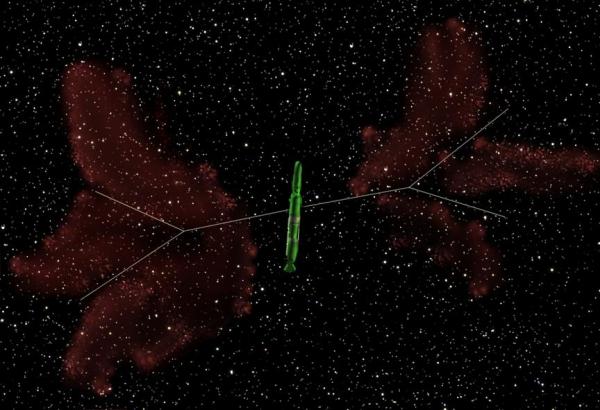BY LETTER
Chillers
Galactography > Other Major Polities, Empires, and Meta-Empires > Hiders
Technology > Application > Transportation > Ships
Technology > Application > Weapons > Space-Based Weapons
Technology > Application > Transportation > Ships
Technology > Application > Weapons > Space-Based Weapons
 Image from Steve Bowers | |
| Stealth ship testing chiller technology in deep space; these wide radiators use the sublimation of a chilled material to maintain an average surface temperature similar to the Cosmic Background radiation | |
Chiller technology has real physical limits but within those limits it can be extremely useful. There are several varieties, from sublimative chillers to neutrino chillers to entropy traps. There is further speculation on transapient technologies beyond this point, but details are not known beyond their existence and extreme effectiveness.
Sublimative chillers are the lowest-tech solution of the three main types. They take waste heat and direct it into a store of chilled material such as water ice which sublimates and hence vents the heat. Obviously, large amounts of material must be used, especially if the heat of the escaping gas is to be kept low and the signature of the vessel reduced. This imposes significant mass penalties, and leaves a secondary trail of gas 'behind' a vessel, which can occasionally be a pointer to it if the enemy checks spectrographic data on stars behind the cloud. (Viewing the spectrograph of a star will indicate if there is matter between it and the viewer). This method has become extremely uncommon among the most technically savvy cultures due to the alternatives' better performance and lack of plume.
Neutrino chillers utilize massive banks of neutrino cooling systems - systems that radiate waste heat as neutrinos. While these do leave a significant signature in the neutrino range, they can be directional, and of course do not deviate from their path unless striking something. (Of course, this tends to make them ineffective in even slightly higher than normal particle counts, as in increased densities of the interstellar plasma, high-solar-wind systems, or nebulae.) There are indications that a few polities may have developed ways to create a destructive beam from such output, allegedly along the lines of a 'neutrino laser' or 'heat beam'. Note also that, unless the vessel in question is careful to maintain minimal energy emissions, the banks of chillers will be quite large and may be impractical to armor - something to dread in a war vessel. There are alternatives - certain clades' battlemoons having mostly hollow cores and large (>1/5th diameter) holes for the radiation to escape, for instance - but those are exceptions to the rule.
Entropy traps are the most expensive system utilized, and for their lifespan the most effective available to baselines at this time. Entropy traps utilize nuclear spin cooling, but in a moderately novel way. The vessel in question typically has one or more 'chiller pods', screens of matter erected with a large central pod. The central pod contains a vacuum flask, which in turn magnetically supports a large block of dense matter and the nuclear-spin cooling apparatus. The matter absorbs the heat generated by the cooling apparatus, and it remains contained within the vacuum flask. Note that the screen itself is typically a low-mass item except for the pod, and relies on heat-superconductivity (as in elemental copper) to retain the temperature set by the chiller pod. Vessels bearing such devices commonly have passive sensor pickups on stalks to probe around the edges of their shields, and may either jettison or retract the shield if main-hull direct-fire weaponry is required. Of course, there is still a danger of occultation revealing the vessel if care is not taken.
A number of Godtech or Clarketech devices are rumoured to exist which can act as heat reservoirs, including massive black hole heat sinks, wormholes, or baby-universe relief valves, but these have yet to be verified beyond doubt and are currently no more than tales.
Related Articles
Appears in Topics
Development Notes
Text by John B
Initially published on 16 September 2004.
Initially published on 16 September 2004.






